|
Anemone
Adventure
I am relatively new to reefkeeping,
but my 48" 55-gallon reef tank is not. The tank was originally
set up as a freshwater tank and then converted over to saltwater
by a co-worker of mine in 1993. In 1998 he decided to upgrade
to a 125-gallon tank, so he gave his old tank and its inhabitants
to his mother who was interested in the hobby. She bought
power compact lighting and began to slowly introduce invertebrates
to the tank during 1999 and 2000. She tired of the maintenance
required, and started toying with the idea of giving the tank
away. I bought the tank and have been its caretaker since
February of 2005.
This was my first saltwater tank, and, has certainly been
a learning experience! I had a couple years of experience
with three freshwater systems: a 30-gallon, a 45-gallon and
a 5-gallon, but I knew this reef tank was going to be a challenge
to properly maintain. I had done a lot of research before
I even knew the tank was available and haven't stopped since.
Fortunately, things have gone pretty well.
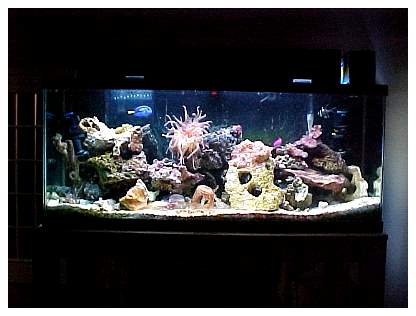 |
When I picked up the tank, the livestock centerpiece was
a beautiful light pink anemone with dark purple spots on its
tentacles' tips. The tank's owner assumed it was a Long tentacle
anemone (Macrodactyla doreensis), but further research
showed it to be a Condylactis anemone. The anemone
was added to the tank sometime around 2002 and was initially
the size of a tennis ball. About a year after it was purchased,
the anemone was sucked into a powerhead and had about two-
thirds of its tentacles ripped off. The anemone recovered
and continued to grow both in size and in beauty, being housed
in deionized filtered water and fed Mysis shrimp and
weekly treats of fresh shrimp pieces. I was told that as its
size increased, so did its color's intensity.
After purchasing the tank and setting into my house, I changed
to a 50GPD Kent R/O water purification system that I purchased
used from an acquaintance that had left the hobby. I also
changed the hang-on-the-back sump from a wet/dry system with
bio-balls to a purely wet system containing some of the tank's
base rock. After making these changes, the nitrates dropped
below detectable levels, and the anemone seemed happy with
the improvement in water quality and prospered for several
months.
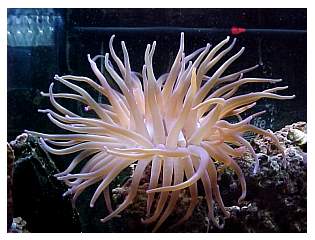 |
I consistently fed the tank half a cube of either Artemia
or Mysis shrimp every day. The anemone continued to
get a treat of a piece of fresh shrimp about once a week,
but it began to grow too large for the tank. When I first
received the anemone it was a little smaller than a volleyball
with its tentacles fully extended. It eventually reached a
size almost equal to a basketball, and there were times when
its tentacles could almost reach the front glass 12 inches
away, with an overall span of roughly 18". Because of
its massive size and incredible growth, I began to decrease
the size of the piece of shrimp I was giving it. I think that
is what caused all the stress I am about to relate.
September 11, 2005
I walked into the living room after
taking my morning shower and was heading to the kitchen when
I saw something "strange" in the tank. I turned
on the lights in the living room because it was still dark
outside and saw that the anemone was on the move. This was
very odd because until that point the only movement it had
made was by creeping on the rocks. But there it was, its body
inflated and floating freely in the tank. I looked at it for
a minute and then I turned on the tank lights, grabbed my
digital camera and took a few pictures. At the time I noticed
that there appeared to be a twist in its body near its foot,
but I didn't think too much about it.
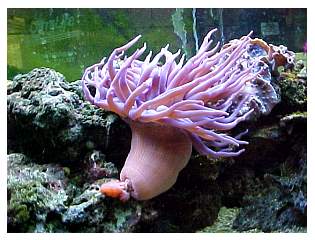 |
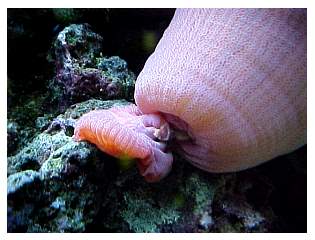 |
I figured I would just turn off the lights and leave it alone
and let it do whatever it was doing, but I came back to the
tank after getting a bite to eat and was shocked to see that
the anemone was stuck to my skimmer's intake tube. I had my
wife run and get a scrubber that came with the tank that had
a long forked handle. I have never used it to clean the tank,
but it works great for reaching things in the tank. While
she was doing that I unplugged the skimmer, turned on the
tank lights, and snapped a picture of the anemone as it was
stuck to the intake tube.
When my wife returned with the scrubber, I gently pulled
the anemone away from the skimmer and placed it back where
it was the night before. It looked a little worse for the
wear and some of its tentacles were deflated, but it reattached
itself to the rocks and seemed okay. I turned the tank lights
back off so they could turn back on at their normal time and
sat down to enjoy the rest of the day.
I kept a close eye on the anemone that morning. It appeared
to be doing well, inflating fully and not trying to move around
anymore. That afternoon I checked on it again and noticed
that the area that had been twisted looked even worse than
it had before. It was very thin and looked more like a rubber
band on a child's toy airplane. I decided I should try to
help it out so I used the scrubber again to try to untwist
the anemone. As soon as I touched it, the anemone broke off
from its foot. The foot was still attached to the rock, but
now the anemone was floating freely in the tank. I gently
placed it into a recessed area in the rocks and called my
friend for his advice. He didn't know what to do, so I just
kept an eye on it. The rest of that day the anemone seemed
okay, but I could see its mesenteries hanging out the hole
where the foot had been attached. Other than that, the anemone
was fully inflated and looked fine.
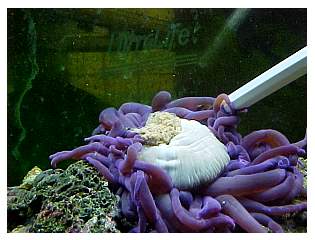 |
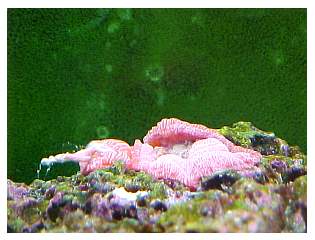 |
The only problem we had was that it would not stay where
we put it. It had no means of attaching to the rock so it
floated away pretty frequently. Out of fear of it getting
sucked into a powerhead, the skimmer or the overflow, I decided
to quarantine it. I got a clean plastic bowl and rinsed it
out well with R/O water. I filled it with tank water, scooped
up the anemone and placed it inside. I floated the bowl in
the tank partially under the light so that it would not get
too intense. To provide some water movement I added an air
stone to the bowl. I changed the water in the bowl twice a
day with water from the tank. The anemone stayed in this for
several days and its condition continued to worsen. It wasn't
expanding much and seemed to be shrinking. By this time a
large portion, if not all, of the mesenteries were sticking
out of the anemone, so I decided to try and put it back into
the main tank.
September 27, 2005
I made a nice place for the anemone's
bowl in the rocks and placed it in there. I didn't want to
take the anemone out of the bowl because it would fall through
the rocks or float away with the current. Almost as soon as
I placed it back into main tank it seemed to have new life.
It partially expanded and looked better than it had since
we had put it into quarantine.
The foot also seemed to be doing well. It was in the same
spot and the foot appeared to be changing colors in places
and almost looked like it was trying to expand a bit more.
September 28, 2005
I came home to find the anemone totally
collapsed and laying at the bottom of the bowl. It actually
looked like it had turned itself inside out. Its mesenteries
circled its body and its mouth was totally open. A hole ran
straight through its body.
I pulled the bowl out of the tank and was met by a strong
fishy odor. It was at this time that I decided enough was
enough and disposed of the anemone. After the dirty work was
done, I took a closer look at the foot and I was surprised
to notice what looked like a mouth forming in the center of
a circle of purple bumps. The purple was the same color as
the tips of the original anemone's tentacles. I thought to
myself, "This thing might grow back!" It was definitely
a much-needed ray of hope.
I began taking photos of the foot's progress at least every
other day.
The next day (the 29th)
the foot inflated more than ever and I could see that the
purple bumps were sticking up a little more.
Just three days later (October 2nd)
it was apparent that the bumps had grown into rounded bubbles
with dark purple tips.
October 4th was the first
time I saw the anemone (this was definitely not just a foot
anymore) expand fully, and it was a very beautiful thing.
The anemone was beginning to look more symmetrical as its
tentacles began to grow longer.
On October 5th the anemone
gave me a scare. By this time it had crept along the rock
and had found a nice hole to call home. I looked into the
tank and was shocked to see that its tentacles were gone and
it looked like just a foot again. I watched for a few seconds
and was relieved to see the mouth spread open a bit and the
tentacles begin to come back out. I grabbed the camera and
took a few pictures to capture the moment. I just wish I could
have taken one before it began to reopen.
|
October 05, 2005
|
October 06, 2005
|
October 7, 2005
I tried feeding the anemone some Mysis
shrimp. The shrimp stuck to the tentacles and I think it might
have moved one piece to its mouth, but I am not sure. I did
take a lot of pictures, though.
October 11, 2005
One month since this all started and
I now have what looks like a healthy anemone. I am simply
amazed at how rapidly the foot has been able to adapt to its
new situation.
Dr. Ron Shimek informed me, "Cnidarians such as anemones
have cells that are "labile." They can change from
one type of cell to another "depending upon the need"
of the organism, presumably in response to some sorts of chemical
cues."
October 13, 2005
I was finally able to photograph the
anemone eating a Mysis shrimp.
It is simply amazing to think that in just a month this anemone
has grown this much. This has been an awe-inspiring experience
that I will never forget. After going through all of the frustration
and emotion of having such a beautiful organism suffer and
die, seeing this new anemone grow "out of the ashes"
makes it all worth it. It is no wonder so many of you are
such dedicated reefkeepers. If this is what it is like, I
can't see how anyone would ever give up this hobby. I am growing
more confident every day that this anemone is going to prosper
in my tank. It has already nearly doubled in size and now
that it is eating I am confident that it will continue to
grow.
I would like to thank everyone on the Reef Central forums
for giving me advice on this tank and especially on this situation.
I would also like to thank Dr. Ronald L. Shimek for his advice,
information and inspiration to document this experience and
share it with you.
If you have any questions about this article, please visit
my author forum
on Reef Central.
|

